
Lepidoptera or lepidopterans is an order of winged insects that includes butterflies and moths. About 180,000 species of the Lepidoptera have been described, representing 10% of the total described species of living organisms, making it the second largest insect order with 126 families and 46 superfamilies. and one of the most widespread and widely recognizable insect orders in the world.

Moths are a group of insects that includes all members of the order Lepidoptera that are not butterflies. They were previously classified as suborder Heterocera, but the group is paraphyletic with respect to butterflies and neither subordinate taxon is used in modern classifications. Moths make up the vast majority of the order. There are approximately 160,000 species of moth, many of which have yet to be described. Most species of moth are nocturnal, although there are also crepuscular and diurnal species.

Lymantria dispar, also known as the gypsy moth or the spongy moth, is a species of moth in the family Erebidae native to Europe and Asia. Lymantria dispar is subdivided into several subspecies, with subspecies such as L. d. dispar and L. d. japonica being clearly identifiable without ambiguity. Lymantria dispar has been introduced to several continents and is now additionally found as an invasive species in Africa, North America and South America. The polyphagous larvae live on a variety of deciduous and coniferous trees and can cause severe damage in years of mass reproduction. Due to these features, Lymantria dispar is listed among the world's 100 worst invasive alien species.

The Tortricidae are a family of moths, commonly known as tortrix moths or leafroller moths, in the order Lepidoptera. This large family has over 11,000 species described, and is the sole member of the superfamily Tortricoidea, although the genus Heliocosma is sometimes placed within this superfamily. Many of these are economically important pests. Olethreutidae is a junior synonym. The typical resting posture is with the wings folded back, producing a rather rounded profile.

The Momphidae, or mompha moths, is a family of moths with some 115 described species. It was described by Gottlieb August Wilhelm Herrich-Schäffer in 1857. These moths tend to be rather small with a wingspan of up to 21 mm. The wings are held folded over the body at rest. The larvae are concealed feeders, either as leaf miners or within seeds or stems.

Mompha raschkiella is a species of micromoth in the family Momphidae. The moth was first described by German entomologist Philipp Christoph Zeller in 1838.

Mompha idaei is a moth in the family Momphidae first described by Philipp Christoph Zeller in 1839. It has a Holarctic distribution; in North America it is found from coast to coast in the boreal forest south to Colorado and Washington.

Mompha epilobiella is a moth in the family Momphidae found in Europe and North America.
BugGuide is a website and online community of naturalists, both amateur and professional, who share observations of arthropods such as insects, spiders, and other related creatures. The website consists of informational guide pages and many thousands of photographs of arthropods from the United States and Canada which are used for identification and research. The non-commercial site is hosted by the Iowa State University Department of Entomology. BugGuide was conceived by photographer Troy Bartlett in 2003 and since 2006 has been maintained by John VanDyk, an adjunct assistant professor of entomology and a senior systems analyst at Iowa State University. The website has been recognized for helping change the public perception of insects.

Mompha is a genus of moths in the family Momphidae that was first described by Jacob Hübner in 1819. It has four subgenera.
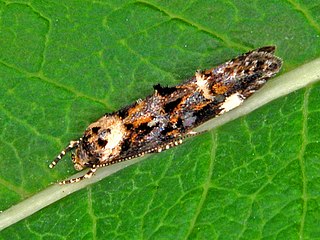
Mompha conturbatella, also known as the fireweed mompha moth, is a moth in the family Momphidae found in Asia, Europe and North America. It was first described by Jacob Hübner in 1819.
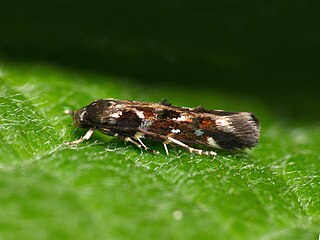
Mompha terminella is a moth in the family Momphidae found in Europe and North America.

Mompha miscella is a moth in the family Momphidae, found in Asia Minor, Europe and North Africa.
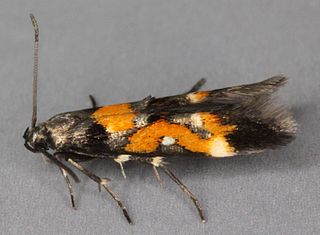
Mompha locupletella is a moth in the family Momphidae that can be found in the Palearctic including Europe.

Mompha circumscriptella, the circumscript mompha moth, is a moth in the family Momphidae. It is found in North America, where it has been recorded from Alabama, Arkansas, British Columbia, California, Florida, Georgia, Illinois, Indiana, Iowa, Kansas, Kentucky, Louisiana, Maine, Maryland, Mississippi, Missouri, Nebraska, New Jersey, North Carolina, Ohio, Oklahoma, South Carolina, Tennessee, Texas and West Virginia.
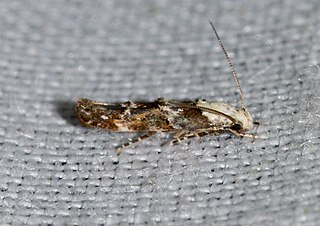
Mompha murtfeldtella is a moth in the family Momphidae. It is found in North America, where it has been recorded from Alabama, California, Florida, Illinois, Indiana, Kansas, Kentucky, Maine, Maryland, Minnesota, Mississippi, North Carolina, Ohio, Oklahoma, Tennessee, Texas and Wisconsin.
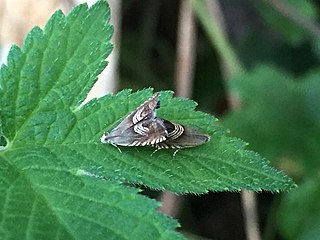
Grapholita delineana, known generally as Eurasian hemp moth, is a species of tortricid moth in the family Tortricidae. Other common names include the hemp moth and hemp borer.

Nemoria elfa, the cypress emerald moth, is a species of emerald in the family Geometridae. It is found in North America.

Zenophleps obscurata is a species of geometrid moth in the family Geometridae. It is endemic to North America.
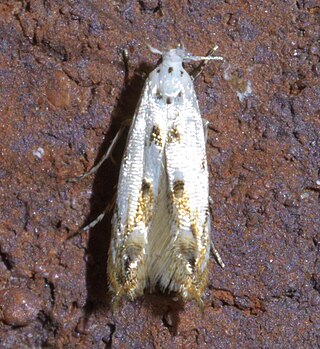
Mompha eloisella, the red-streaked mompha, is a species of momphid moth in the family Momphidae.

















